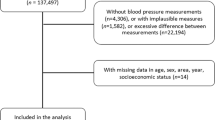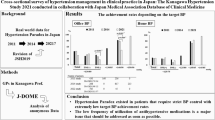Abstract
From the national surveys of Japan over a 55-year period (1961–2016), a steady decrease was observed in systolic blood pressure (BP) levels among all age groups of men and women, but not in diastolic BP levels—particularly among men. Hypertension prevalence remains high: over 60% of men aged ≥50 years and women aged ≥60 years had hypertension in 2016. However, the control rates of hypertension have continuously improved over a 36-year period, and were ~40% in 2016. Nonetheless, the over 50% prevalence of uncontrolled hypertension is a major risk factor for future cardiovascular diseases. Of the estimated 43 million hypertensives in Japan, most (31 million, 72%) were under poor control. According to new Japanese hypertension guidelines (JSH 2019), there will be only a small increase (2.2 million, 2.1 percentage points) in adults who are recommended for antihypertensive medication compared with 2014 guidelines. However, an additional 5.3 million (22.1 percentage points) adults taking antihypertensive medication would have a BP above the target defined by JSH 2019. The number of hypertensives with poor control was targeted to decrease by 7 million—from 31 million in 2017 to 24 million in 2028—when the followings are achieved: (1) the prevalence of hypertension decreases by 5 percentage points; (2) the treatment rate of hypertension among hypertensives increases by 10 percentage points; and (3) the control rate of hypertension, defined as BP <140/90 mmHg, among individuals taking antihypertensive medication increases by 10 percentage points. Both high-risk and population strategies to manage and prevent hypertension deserve greater priority.
This is a preview of subscription content, access via your institution
Access options
Subscribe to this journal
Receive 12 print issues and online access
$259.00 per year
only $21.58 per issue
Buy this article
- Purchase on Springer Link
- Instant access to full article PDF
Prices may be subject to local taxes which are calculated during checkout









Similar content being viewed by others
References
Umemura S, Arima H, Arima S, Asayama K, Dohi Y, Hirooka Y, et al. The Japanese Society of Hypertension Guidelines for the Management of Hypertension (JSH 2019). Hypertens Res. 2019;42:1235–481.
Fujiyoshi A, Ohkubo T, Miura K, Murakami Y, Nagasawa SY, Okamura T, et al. Blood pressure categories and long-term risk of cardiovascular disease according to age group in Japanese men and women. Hypertens Res. 2012;35:947–53.
Ikeda N, Inoue M, Iso H, Ikeda S, Satoh T, Noda M, et al. Adult mortality attributable to preventable risk factors for non-communicable diseases and injuries in Japan: a comparative risk assessment. PLoS Med. 2012;9:e1001160.
GBD 2017 Risk Factor Collaborators. Global, regional, and national comparative risk assessment of 84 behavioural, environmental and occupational, and metabolic risks or clusters of risks for 195 countries and territories, 1990–2017: a systematic analysis for the Global Burden of Disease Study 2017. Lancet. 2018;392:1923–94.
Mills KT, Bundy JD, Kelly TN, Reed JE, Kearney PM, Reynolds K, et al. Global disparities of hypertension prevalence and control: a systematic analysis of population-based studies from 90 countries. Circulation. 2016;134:441–50.
Forouzanfar MH, Liu P, Roth GA, Ng M, Biryukov S, Marczak L, et al. Global burden of hypertension and systolic blood pressure of at least 110 to 115 mm Hg, 1990–2015. JAMA. 2017;317:165–82.
Lewington S, Clarke R, Qizilbash N, Peto R, Collins R, Prospective Studies C. Age-specific relevance of usual blood pressure to vascular mortality: a meta-analysis of individual data for one million adults in 61 prospective studies. Lancet. 2002;360:1903–13.
Bundy JD, Li C, Stuchlik P, Bu X, Kelly TN, Mills KT, et al. Systolic blood pressure reduction and risk of cardiovascular disease and mortality: a systematic review and network meta-analysis. JAMA Cardiol. 2017;2:775–81.
Ueshima H. Explanation for the Japanese paradox: prevention of increase in coronary heart disease and reduction in stroke. J Atheroscler Thromb. 2007;14:278–86.
Miura K. Epidemiology and prevention of hypertension in Japanese: how could Japan get longevity? EPMA J. 2011;2:59–64.
Miura K, Nagai M, Ohkubo T. Epidemiology of hypertension in Japan: where are we now? Circ J. 2013;77:2226–31.
Miura K. Report for a Health and Labour Sciences Research Grant, Japan (Comprehensive research on life-style related diseases including cardiovascular diseases and diabetes mellitus [H30-Jyunkankitou-Seisyu-Sitei-002]). 2019. (in Japanese).
Nagai M, Ohkubo T, Murakami Y, Takashima N, Kadota A, Miyagawa N, et al. Secular trends of the impact of overweight and obesity on hypertension in Japan, 1980–2010. Hypertens Res. 2015;38:790–5.
Miura K. Report for a Health and Labour Sciences Research Grant, Japan (Comprehensive research on life-style related diseases including cardiovascular diseases and diabetes mellitus [H30-Jyunkankitou-Seisyu-Sitei-002]). 2020. (in Japanese.).
Satoh A, Arima H, Ohkubo T, Nishi N, Okuda N, Ae R, et al. Associations of socioeconomic status with prevalence, awareness, treatment, and control of hypertension in a general Japanese population: NIPPON DATA2010. J Hypertens. 2017;35:401–8.
Muntner P, Carey RM, Gidding S, Jones DW, Taler SJ, Wright JT Jr, et al. Potential US population impact of the 2017 ACC/AHA high blood pressure guideline. Circulation. 2018;137:109–18.
Node K, Kishi T, Tanaka A, Itoh H, Rakugi H, Ohya Y, et al. The Japanese Society of Hypertension—digest of plan for the future. Hypertens Res. 2018;41:989–90.
Pereira M, Lunet N, Azevedo A, Barros H. Differences in prevalence, awareness, treatment and control of hypertension between developing and developed countries. J Hypertens. 2009;27:963–75.
Chow CK, Teo KK, Rangarajan S, Islam S, Gupta R, Avezum A, et al. Prevalence, awareness, treatment, and control of hypertension in rural and urban communities in high-, middle-, and low-income countries. JAMA. 2013;310:959–68.
Takashima N, Ohkubo T, Miura K, Okamura T, Murakami Y, Fujiyoshi A, et al. Long-term risk of BP values above normal for cardiovascular mortality: a 24-year observation of Japanese aged 30 to 92 years. J Hypertens. 2012;30:2299–306.
Ikeda A, Iso H, Yamagishi K, Inoue M, Tsugane S. Blood pressure and the risk of stroke, cardiovascular disease, and all-cause mortality among Japanese: the JPHC Study. Am J Hypertens. 2009;22:273–80.
Arima H, Tanizaki Y, Yonemoto K, Doi Y, Ninomiya T, Hata J, et al. Impact of blood pressure levels on different types of stroke: the Hisayama study. J Hypertens. 2009;27:2437–43.
Imano H, Kitamura A, Sato S, Kiyama M, Ohira T, Yamagishi K, et al. Trends for blood pressure and its contribution to stroke incidence in the middle-aged Japanese population: the Circulatory Risk in Communities Study (CIRCS). Stroke. 2009;40:1571–7.
Funding
The NIPPON DATA80/90/2010 were supported by Grants-in-Aid from the Ministry of Health, Labor and Welfare under the auspices of the Japanese Association for Cerebro-cardiovascular Disease Control; a Research Grant for Cardiovascular Diseases (7A-2) from the Ministry of Health, Labor and Welfare; and a Health and Labor Sciences Research Grant, Japan (Comprehensive Research on Aging and Health [H11-Chouju-046, H14-Chouju-003, H17-Chouju-012, H19-Chouju-Ippan-014]; and Comprehensive Research on Life-Style Related Diseases including CVDs and Diabetes Mellitus [H22-Junkankitou-Seishuu-Sitei-017, H25-Junkankitou-Seishuu-Sitei-022, H30-Junkankitou-Seishuu-Sitei-002]).
Author information
Authors and Affiliations
Corresponding author
Ethics declarations
Conflict of interest
The authors declare that they have no conflict of interest.
Additional information
Publisher’s note Springer Nature remains neutral with regard to jurisdictional claims in published maps and institutional affiliations.
Rights and permissions
About this article
Cite this article
Hisamatsu, T., Segawa, H., Kadota, A. et al. Epidemiology of hypertension in Japan: beyond the new 2019 Japanese guidelines. Hypertens Res 43, 1344–1351 (2020). https://doi.org/10.1038/s41440-020-0508-z
Received:
Revised:
Accepted:
Published:
Issue Date:
DOI: https://doi.org/10.1038/s41440-020-0508-z
Keywords
This article is cited by
-
High blood pressure in childhood and adolescence
Hypertension Research (2024)
-
The impact of clinical inertia on uncontrolled blood pressure in treated hypertension: real-world, longitudinal data from Japan
Hypertension Research (2024)
-
Secular trends and age-specific distribution of blood pressure in Japanese adolescents aged 12–18 years in 2000–2019
Hypertension Research (2024)
-
Dietary patterns associated with the incidence of hypertension among adult Japanese males: application of machine learning to a cohort study
European Journal of Nutrition (2024)
-
Relationship between antihypertensive drug use and number of people with high blood pressure in FY 2018: a descriptive epidemiological study based on the National Database of Health Insurance Claims and Specific Health Checkups of Japan open data
Journal of Pharmaceutical Health Care and Sciences (2023)



